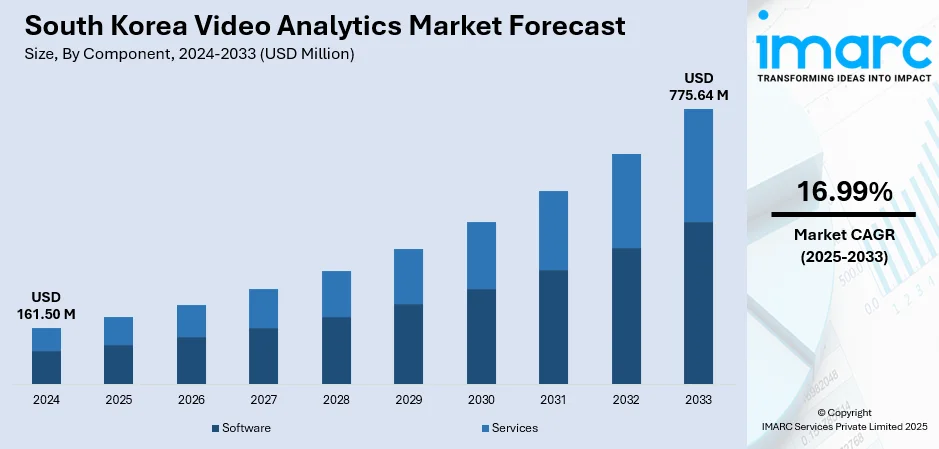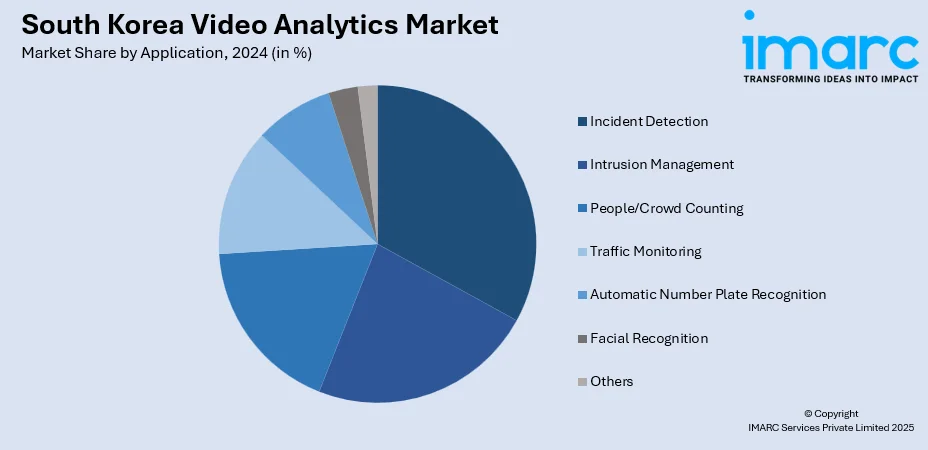
South Korea Video Analytics Market Size, Share, Trends and Forecast by Component, Deployment Type, Application, Architecture Type, Organization Size, End User, and Region, 2025-2033
South Korea Video Analytics Market Overview:
The South Korea video analytics market size reached USD 161.50 Million in 2024. The market is projected to reach USD 775.64 Million by 2033, exhibiting a growth rate (CAGR) of 16.99% during 2025-2033. The market is growing steadily, driven by advancements in component technologies and diverse deployment types. The market serves multiple applications including pharmaceuticals, environmental analysis, and food safety, supported by various architecture types and organizational scales. Key end users span healthcare, research institutions, and industrial sectors, all benefiting from enhanced analytical precision and efficiency. Innovations continue to propel market adoption, positioning a competitive player in this field. These trends are shaping the South Korea video analytics market share.
|
Report Attribute
|
Key Statistics
|
|---|---|
|
Base Year
|
2024
|
|
Forecast Years
|
2025-2033
|
|
Historical Years
|
2019-2024
|
| Market Size in 2024 | USD 161.50 Million |
| Market Forecast in 2033 | USD 775.64 Million |
| Market Growth Rate 2025-2033 | 16.99% |
South Korea Video Analytics Market Trends:
AI-Driven Detection of Online Exploitation Content
In May 2025, the Seoul Metropolitan Government introduced a powerful AI system that detects and reports online sexual exploitation videos within just six minutes. Previously, this process could have taken hours, but now authorities can act almost in real time. The system uses advanced multimodal large language models combined with web automation to analyze video, audio, and text content simultaneously. It can autonomously generate detailed reports and removal requests in seven languages, expanding its reach across various online platforms. Operating continuously, this AI technology improves detection accuracy and accelerates the removal of harmful content, offering stronger protection to victims. This innovative approach not only enhances public safety but also sets a new benchmark for video analytics applications in government operations. The capability to quickly identify an act on illicit content reflects the broader shifts in technology adoption. These advancements contribute significantly to driving South Korea video analytics market growth by demonstrating how AI can address complex social issues efficiently.

To get more information on this market, Request Sample
Expansion of Edge AI Camera Offerings
In January 2024, IDIS increased its Edge AI range of cameras to offer wider availability of state-of-the-art deep learning video analytics to commercial, public, and perimeter security markets. Its lineup of nine models bullets, domes, and turrets with the IDIS Deep Learning Engine allows accurate detection and automatic tracking of suspicious people and vehicles. The cameras are plug-and-play compliant for easy and fast installation. Some of the key features are NIR Lightmaster technology for improved night vision, real wide dynamic range (WDR) for improved image sharpness in demanding lighting, and H.265 compression to minimize storage and bandwidth. They are also designed to meet stringent security standards and feature smart failover performance to make certain that they continue to operate around the clock. ONVIF compatibility guarantees smooth integration with current security systems. The new series of cameras illustrates South Korea's continued focus on incorporating AI-based solutions into its security landscape. This development follows South Korea video analytics market trends by offering more advanced, effective, and smart monitoring solutions across various environments.
Open Government Data Boosts Video Analytics
In October 2024, South Korea’s National Information Society Agency (NIA) launched a large-scale open-data initiative to accelerate AI and video analytics development across both public and private sectors. The initiative made more than 87,000 datasets and 11,000 APIs available through the AI Hub and national Open Data Portal. These include anonymized public camera feeds, urban mobility data, and event-schedule datasets rich formats ideal for developers to build real-time video analytics applications such as crowd monitoring, license-plate recognition, and anomaly detection in transportation hubs and city centers. Strong privacy provisions were embedded using pseudonymization techniques and ethical guidelines under the Personal Information Protection Commission, ensuring compliance with privacy standards while enabling innovation. This effort empowers civic tech labs, startups, and municipal IT teams to access high-quality, government-certified data to train and test video-based models tuned to Korea’s urban environments. By standardizing and scaling data access, the program accelerates real-time decision-making in areas like transit flow and public safety
South Korea Video Analytics Market Segmentation:
IMARC Group provides an analysis of the key trends in each segment of the market, along with forecasts at the country and regional levels for 2025-2033. Our report has categorized the market based on component, deployment type, application, architecture type, organization size, and end user.
Component Insights:
- Software
- Services
The report has provided a detailed breakup and analysis of the market based on the component. This includes software and services.
Deployment Type Insights:
- On-premises
- Cloud-based
A detailed breakup and analysis of the market based on the deployment type have also been provided in the report. This includes on-premises and cloud-based.
Application Insights:

- Incident Detection
- Intrusion Management
- People/Crowd Counting
- Traffic Monitoring
- Automatic Number Plate Recognition
- Facial Recognition
- Others
The report has provided a detailed breakup and analysis of the market based on the application. This includes incident detection, intrusion management, people/crowd counting, traffic monitoring, automatic number plate recognition, facial recognition, and others.
Architecture Type Insights:
- Edge-based
- Server-based
A detailed breakup and analysis of the market based on the architecture type have also been provided in the report. This includes edge-based and server-based.
Organization Size Insights:
- Small and Medium-sized Enterprises
- Large Enterprises
The report has provided a detailed breakup and analysis of the market based on the organization size. This includes small and medium-sized enterprises and large enterprises.
End User Insights:
- BFSI
- Retail
- Critical Infrastructure
- Traffic Management
- Transportation and Logistics
- Hospitality and Entertainment
- Defense and Security
- Others
A detailed breakup and analysis of the market based on the end user have also been provided in the report. This includes BFSI, retail, critical infrastructure, traffic management, transportation and logistics, hospitality and entertainment, defense and security, and others.
Regional Insights:
- Seoul Capital Area
- Yeongnam (Southeastern Region)
- Honam (Southwestern Region)
- Hoseo (Central Region)
- Others
The report has also provided a comprehensive analysis of all the major regional markets, which include the Seoul Capital Area, Yeongnam (Southeastern Region), Honam (Southwestern Region), Hoseo (Central Region), and others.
Competitive Landscape:
The market research report has also provided a comprehensive analysis of the competitive landscape. Competitive analysis such as market structure, key player positioning, top winning strategies, competitive dashboard, and company evaluation quadrant has been covered in the report. Also, detailed profiles of all major companies have been provided.
South Korea Video Analytics Market News:
- December 2024: SK Telecom has strategically invested in US-based tech startup American Twelve Labs, which specializes in AI-driven video analysis. The investment aims at expanding the capability of SK Telecom to index and analyzing vast volumes of video content. This move aligns with the bigger plan of the company to be at the forefront of AI innovation not only in South Korea but globally. Through the integration of advanced AI video analysis technologies, SK Telecom will further enrich content discovery, retrieval, and monetization, cementing its position of leadership in the nation's telecommunication and technology industry.
South Korea Video Analytics Market Report Coverage:
| Report Features | Details |
|---|---|
| Base Year of the Analysis | 2024 |
| Historical Period | 2019-2024 |
| Forecast Period | 2025-2033 |
| Units | Million USD |
| Scope of the Report |
Exploration of Historical Trends and Market Outlook, Industry Catalysts and Challenges, Segment-Wise Historical and Future Market Assessment:
|
| Components Covered | Software, Services |
| Deployment Types Covered | On-premises, Cloud-based |
| Applications Covered | Incident Detection, Intrusion Management, People/Crowd Counting, Traffic Monitoring, Automatic Number Plate Recognition, Facial Recognition, Others |
| Architecture Types Covered | Edge-based, Server-based |
| Organization Sizes Covered | Small and Medium-sized Enterprises, Large Enterprises |
| End Users Covered | BFSI, Retail, Critical Infrastructure, Traffic Management, Transportation and Logistics, Hospitality and Entertainment, Defense and Security, Others |
| Regions Covered | Seoul Capital Area, Yeongnam (Southeastern Region), Honam (Southwestern Region), Hoseo (Central Region), Others |
| Customization Scope | 10% Free Customization |
| Post-Sale Analyst Support | 10-12 Weeks |
| Delivery Format | PDF and Excel through Email (We can also provide the editable version of the report in PPT/Word format on special request) |
Key Questions Answered in This Report:
- How has the South Korea video analytics market performed so far and how will it perform in the coming years?
- What is the breakup of the South Korea video analytics market on the basis of component?
- What is the breakup of the South Korea video analytics market on the basis of deployment type?
- What is the breakup of the South Korea video analytics market on the basis of application?
- What is the breakup of the South Korea video analytics market on the basis of architecture type?
- What is the breakup of the South Korea video analytics market on the basis of organization size?
- What is the breakup of the South Korea video analytics market on the basis of end user?
- What is the breakup of the South Korea video analytics market on the basis of region?
- What are the various stages in the value chain of the South Korea video analytics market?
- What are the key driving factors and challenges in the South Korea video analytics market?
- What is the structure of the South Korea video analytics market and who are the key players?
- What is the degree of competition in the South Korea video analytics market?
Key Benefits for Stakeholders:
- IMARC’s industry report offers a comprehensive quantitative analysis of various market segments, historical and current market trends, market forecasts, and dynamics of the South Korea video analytics market from 2019-2033.
- The research report provides the latest information on the market drivers, challenges, and opportunities in the South Korea video analytics market.
- Porter's five forces analysis assist stakeholders in assessing the impact of new entrants, competitive rivalry, supplier power, buyer power, and the threat of substitution. It helps stakeholders to analyze the level of competition within the South Korea video analytics industry and its attractiveness.
- Competitive landscape allows stakeholders to understand their competitive environment and provides an insight into the current positions of key players in the market.
Need more help?
- Speak to our experienced analysts for insights on the current market scenarios.
- Include additional segments and countries to customize the report as per your requirement.
- Gain an unparalleled competitive advantage in your domain by understanding how to utilize the report and positively impacting your operations and revenue.
- For further assistance, please connect with our analysts.
 Request Customization
Request Customization
 Speak to an Analyst
Speak to an Analyst
 Request Brochure
Request Brochure
 Inquire Before Buying
Inquire Before Buying




.webp)




.webp)












